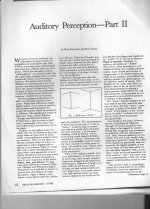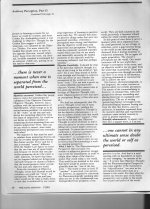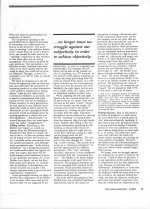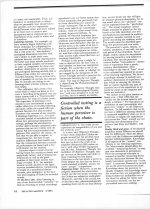The problem with this whole GE/DB thing is that fundamentally humans hear what they want to hear, and discard or minimize what they don't. In social interactions, more communications information is passed via the visual domain through facial expressions (taking place IIUC the milli-second time frame and totally in the sub-conciuous realm). Thus, two peoplel can look you in the eye and say 'pleased to meet you' yet you perceive one as a b.s. artist and the other as genuine.
For audio, if we are to purely judge the performance of something in the auditory realm, it seems to me we have to suspend the confounding inputs from the visual senses for the reasons stated above.
I have noted before that the physical world is profoundly non-intuitive while humans are exactly the opposite. It is for this reason that most people will hang onto any explanation (religion, philosophy - you name it) rather than deal with the difficult, intellectually challenging one: the truth and wherever that my lead.
For audio, if we are to purely judge the performance of something in the auditory realm, it seems to me we have to suspend the confounding inputs from the visual senses for the reasons stated above.
I have noted before that the physical world is profoundly non-intuitive while humans are exactly the opposite. It is for this reason that most people will hang onto any explanation (religion, philosophy - you name it) rather than deal with the difficult, intellectually challenging one: the truth and wherever that my lead.
There is a certain style of oratory, seen in political conferences and some religious settings, where the aim is not to challenge the assumptions of the faithful and encourage them to reform their ways and to do better but instead to reassure them that they are right and all the unbelievers out there are wrong. People not present are criticised - but they won't hear it so it does them no good even when it is true. People present leave with a warm glow, and a renewed determination not to fall back into unbelief.john curl said:As they say: "You can lead a horse to water, but ... "
That article came from that school of oratory. It was not intended to convince people who demand evidence that they are mistaken; it was intended to reassure people who need no evidence that they are right, and that they should not be tempted into leaving the one true fold.
Last edited:
I read the first page. He seems typical of people who talk about science; I assume he didn't actually do much physical science? Not worth reading the rest, as it seems designed to massage the egos of true believers and affirm them in their beliefs, rather than seriously challenge the alternative view that listening tests should involve ears alone. Does he seriously not know the difference between 'blind listening' and 'blind meter reading'?
It is always nice to know how weak is the argument of the other side. Thanks, John, for exposing this.
You should read the rest, to stop because "it seems that ....." isn´t really sensible.
What if it´s correct what the authors wrote (btw it quite often is)? Not worth to read or to mention, because it is "designed to massage the egos of true believers" ??
Btw, you are still using the phrase "ears alone" although ýou know (at least you should know) that it is a misnomer. Humans can´t process anything "ears alone" .....
Is it really so hard to use a term that is correct and not misleading as "ears only" ?
Alas, I read the whole thing. I drew me in, like a bad horror novel.
I was thinking the same thing, but could not believe it could be so easy.
Care to explain which argument´s were so weak?
There was one thing I did like, blind meter reading. I have been guilty of interpreting measurements with bias. You do have to be careful about that.
Fascinating isn´t it?
The reality is at that point even more depressing, because as long as a listener is convinced that a certain effect isn´t audible he is allowed to stick with sighted listening, provided the results confirm his prior believes. Strange world... 😉
<snip>
That article came from that school of oratory. It was not intended to convince people who demand evidence that they are mistaken; it was intended to reassure people who need no evidence that they are right, and that they should not be tempted into leaving the one true fold.
You must possess supernatural powers. 🙂
But to be serious, you have written two posts on this topic and i couldn´t find any specific argument that contradicts the author´s view not even an attempt to provide something profound.
So what is the aim of your posts? Were these intended just to reassure people that they are right and to discourage them to read something that might question their beliefs?
Is that really the way a discussion forum should work?
One example of the buffer size in a CD player DSP with built in Micro controller is the Sony LC78601 used in the Shigaclone.
This has a buffer of 2Kx8bits as do the other three controllers I looked up. All four controllers were by SONY, so other manufacturers may select a different size buffer depending on their architecture.
This has a buffer of 2Kx8bits as do the other three controllers I looked up. All four controllers were by SONY, so other manufacturers may select a different size buffer depending on their architecture.
Given the response of the last article, I thought that another article might be welcomed. '-) Please remember these articles were written by professors, who, at the time, did this stuff for a living. Remember your backgrounds guys (academic physics, audio repair, circuit layout, other industrial processes) when criticizing these 2 professors:
Attachments
By "did this stuff for a living," you mean writing gassy woffle for hobbyist magazines?
Seriously, this is pitiful. I wish you had 5% of the curiosity and open-mindedness of James, you could be doing so much more.
Seriously, this is pitiful. I wish you had 5% of the curiosity and open-mindedness of James, you could be doing so much more.
More woffle. The two lines in the diagram either are, or are not, the same length. Whatever they actually are, no amount of sincere subjectivity will change them to be something other. So he seems to be admitting that what he rudely calls 'meter reading' actually gives the truth, but people often subjectively perceive something different and he prefers their mistaken beliefs - or at least he regards truth and error to be equally valid versions of truth. In other words, if I believe that red cars go faster then for me in my own private universe red cars really do go faster even if all 'meter reading' shows this to be false and there is no plausible reason why red cars should be faster.
Just because someone is a professor (of what?) does not mean that what he says is true. I only read the first page. The first page of a good article is supposed to draw the reader in; create curiosity even in those of a different persuasion. This fails to do that for me. What it actually says to me is 'I don't have a good argument, but I will try to bore you into submission or impress you by giving a long and superficially academic argument'.
Just because someone is a professor (of what?) does not mean that what he says is true. I only read the first page. The first page of a good article is supposed to draw the reader in; create curiosity even in those of a different persuasion. This fails to do that for me. What it actually says to me is 'I don't have a good argument, but I will try to bore you into submission or impress you by giving a long and superficially academic argument'.
Ok I wonder how many honestly think all SPDIF digital source run at same sampling rate sounds the same ?
(Assuming bit transfer is perfect, most equipment will be tested for that at factory anyway, simple test)
I personally don't find all sound the same.
I think same can be said about CD transport.
I think this is quite logical.
Poll ? 😀
(Assuming bit transfer is perfect, most equipment will be tested for that at factory anyway, simple test)
I personally don't find all sound the same.
I think same can be said about CD transport.
I think this is quite logical.
Poll ? 😀
Ok I wonder how many honestly think all SPDIF digital source run at same sampling rate sounds the same ?
(Assuming bit transfer is perfect, most equipment will be tested for that at factory anyway, simple test)
I personally don't find all sound the same.
I think same can be said about CD transport.
I think this is quite logical.
Poll ? 😀
Interesting. What logic is that, that makes you think they should sound different?
Jan
What does it matter what we think? The issue is not what we think, but what is actually true. This is the fundamental point. If something is true then no matter how hard I or others believe it not to be true it will still remain true.
When someone speaks about what something sounds like, then all we ask is that it is sound alone which determines the result. Not the price, not the packaging, not the designer's reputation, not the opinion of journalists etc.; all these may influence a purchasing decision but none of them change the actual sound, although we know that they can affect the perception of sound.
When someone speaks about what something sounds like, then all we ask is that it is sound alone which determines the result. Not the price, not the packaging, not the designer's reputation, not the opinion of journalists etc.; all these may influence a purchasing decision but none of them change the actual sound, although we know that they can affect the perception of sound.
We may have to rename you Dave Quixote. 😛
At least I got one person via PM interested in doing the bit perfect test. I put a little dent in the windmill.
At least I got one person via PM interested in doing the bit perfect test. I put a little dent in the windmill.
I don't understand what you are talking about Jakob.
Don't worry, you are not alone. Obfuscating is a well known diversion method. Next step is training for training the trainer who trains the subjects.
Interesting. What logic is that, that makes you think they should sound different?
Jan
First is the CM noise interaction between transport and device it is connected. Via cabling or radiation.
Second is the transport jitter vs DAC jitter interaction. Some transport have lower jitter than DAC and vice versa.
Third the SPDIF waveform itself, different transport has differing waveform harmonic. Which can interact with DAC in various manner.
I agree, I have no expectations for anyone to hear the difference. My only point is I don't expect, nor believe, or have representation that CD's streaming are bit perfect. My only reasoning for a difference in sound from transports is related to noise and improper design.
Now, how much does noise matter? That could be a potentially significant difference.
It SHOULDN'T matter, that is the crux of the matter... Look at sound cards inside PC's with excellent figures, a stand alone DAC should be designed correctly so as not to be affected by noise from a previous stage....
EMC compatibility engineering and signal integrity, been there for years so there are no excuses for modern kit.....
I posted this 2 days and over 70 posts ago. Not one peep from anyone. Should I conclude that no one is really interested in finding out for themselves?
OK, by me - it's a lot less work. 😀
I would have taken up your offer, but all my music is on a serever.... sorry🙂
Btw, you are still using the phrase "ears alone" although ýou know (at least you should know) that it is a misnomer. Humans can´t process anything "ly"ears alone" .....
?
It is a term that is often used and the meaning of is well understood by most if bot all on this forum, why keep going on about it. Language is not perfect, we could spend all our time discussing the foibles and meanings of the English language, but this is not what we are discussing, why be so pedantic over one little point....
First is the CM noise interaction between transport and device it is connected. Via cabling or radiation.
Second is the transport jitter vs DAC jitter interaction. Some transport have lower jitter than DAC and vice versa.
Third the SPDIF waveform itself, different transport has differing waveform harmonic. Which can interact with DAC in various manner.
Have you measured this common mode noise... what about differential mode noise, you seem to be sprouting some mantra that I have heard before regarding this subject... lets have some figures and what happens downstream with this EMI and why is it not accounted for in the design of the CAD.
You don't understand jitter much....
- Status
- Not open for further replies.
- Home
- Member Areas
- The Lounge
- Ping: John Curl. CDT/CDP transports



